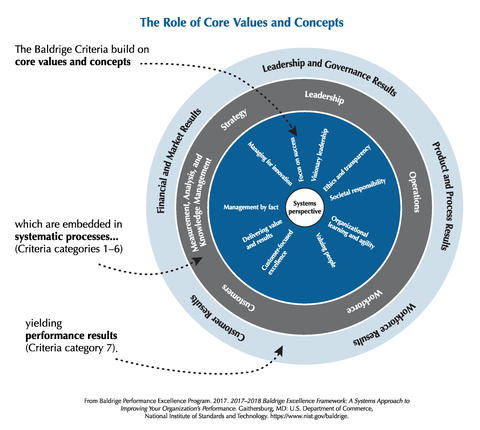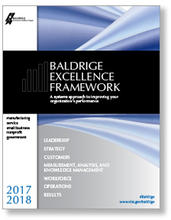Blogrige
The Official Baldrige Blog

Vacation
I recently returned from a family vacation to Hawaii. Our family vacations involve nine people: my wife and I, my two sons and their wives, and my three granddaughters. While we have downtime, we generally plan our days for activities we all enjoy and in which we can all participate (ages 6 through, ah-hem, senior citizens). I know there are also families who plan their vacations differently, for example independent activities during the day and then a communal dinner.
Strategic Alignment
By now you are probably asking, what could this possibly have to do with strategic alignment? Well, I recently read a blog about strategic alignment, in which Dennis Miller discusses the importance of strategic alignment in nonprofit organizations. He defines strategic alignment as, "the process of aligning all stakeholders, internal and external, so that all are focused and committed to achieving a shared organizational vision." Well, our family had a shared vision of having a great, once-in-a-lifetime, vacation in Hawaii. And we had to align all our individual desires and gain cooperation of external partners, like the luau providers. Was that strategic alignment? It was challenging at times and strategic alignment is difficult. However, I began to wonder, isn't there more to true organizational strategic alignment than the alignment of people, although that alone can certainly be a challenge.
I did some literature searching to see if there was general agreement on the definition of strategic alignment. I found two articles in the Houston Chronicle about strategic alignment, with a focus on for-profit companies. The first article, by Steven Symes, defines strategic alignment as, "what matters most to the organization and then create a road map to achieving the organization's purpose." The article goes on to indicate that alignment requires planning, a willingness to make adjustments, and an involved workforce. So this definition focused on the planning process. The second article, by Flora Richards-Gustafson, defines strategic alignment as, "lining up a business' strategy with its culture." The approach according to Richards-Gustafson is a process that requires management to change and align its vision with leadership goals, organizational culture, and individual staff members. So, maybe our family wasn't in strategic alignment, since there were no "leadership" goals that others had to align with?
Finally, I went to the source of all knowledge, Wikipedia, which defines strategic alignment as, "the process and the result of linking an organization's structure and resources with its strategy and business environment (regulatory, physical, etc)". So, is strategic alignment about use of SWOT or PEST analysis?
Systems Perspective
In the end, I think all of these concepts are important to strategic alignment. But, in my opinion (and I am biased), the critical organizational concept is one of a systems perspective. It is the first of the 11 Baldrige Core Values and Concepts.

A systems perspective means, "managing all components of your organization as a unified whole to achieve your mission, ongoing success, and performance excellence."
You need to view the organization as a system with interdependent operations that need to operate in a unified and mutually beneficial manner. It incorporates key business attributes, including core competencies, strategic objectives, action plans, work systems, and workforce needs.
How does your organization operate? With a systems perspective or a more narrow approach of (choose your definition!) strategic alignment ?
A Systems Approach to Improving Your Organization’s Performance

Baldrige Excellence Framework
The Baldrige Excellence Framework has empowered organizations to accomplish their missions, improve results, and become more competitive. It includes the Criteria for Performance Excellence, core values and concepts, and guidelines for evaluating your processes and results.
Purchase your copy today!
Available versions: Business/Nonprofit, Education, and Health Care
About the author
Related Posts
Comments
Thanks for the comment. I would say that Baldrige does not tell you how to standardize or map a process, but it does focus the organization on being process driven. Quality tools provide the how for achieving process rigor and driving out waste. I believe Baldrige and Quality combined have served the community well in achieving process standardization. Baldrige provides the systems perspective, and the focus on results and learning. Tools, like LEAN, provide the process rigor.
Sometimes “the” greatest shortcoming is also “the” greatest strength.
“The” strength of Baldrige is that over 100 recipient organizations have documented “how” they used a variety of systematic, integrated approaches to achieve high levels of performance excellence.
Another great post, Harry. Glad HI was a great experience.
Here are some thoughts about alignment:
“If everyone is moving forward together, then success takes care of itself.” -- Henry Ford
If your organization is not explicitly aligned in the way everyone articulates your mission, vision, values, and goals, your actions are not likely to be focused in the same direction. And with everyone playing a different game, your chances of winning are dramatically reduced.
Establishing the core context of an organization is not for hanging posters with mission and vision statements. It is for establishing the framework that drives your organization to new levels of performance excellence.
“Context is worth 80 IQ points.” – Alan Kay, computer scientist
By including people throughout your organization, you enroll people from the start, rather than seeking buy-in when the core is already set and a sense of ownership is far harder to achieve.
To deploy that strategic framework throughout your organization in a powerful way, the leadership team and front-line people set bold goals, along with the small steps needed to achieve them. Powerful goals give everyone a reason to drive in the same direction, committed to the same results. Without common goals, everyone naturally pursues their own agenda.
I do not know who to attribute this aphorism to, but I have seen it in several publications and heard it in several presentations. It seems to speak to the elusive "nugget and legendary "gist" of this topic.
Having a vision without a strategy is dream. Having a strategy without a vision is hope.
I love the analogy to illustrate the various viewpoints. It amazes me how so many leaders (even within the same organization) can have such diverse perspectives and understanding of the concept - and then seem perplexed as to why the organization struggles in its strategy, execution and / or business results.
Thanks for sharing!!
Very Informative Post
1. You have as many cultures as you have supervisors.
2. Approximately 15% of employees are "not engaged," 30% are "fully engaged," and the rest -- 55% or so are neither.
3. People join organizations because of its vision; they leave because of their supervisors.
These points from Gallup worldwide surveys tells us that the critical leverage points for deploying vision and culture to "everyone" are work group supervisors.
I agree that workplace supervisors are the critical people link. The systems perspective says that people, strategy, and process are needed to achieve the vision and a high-performing culture.
This was an interesting read Harry. My personal definition is that "Strategic alignment is when your leadership, product, marketing, and sales functions are all pulling in the same direction—with clarity, consistency, and purpose. It’s not about forcing agreement. It’s about building a shared operating system that connects your vision to your execution—so that every decision, message, and investment reinforces your strategy instead of competing with it." ( https://chriscureton.com/glossary-of-terms/what-is-strategic-alignment )






The major shortcoming of Baldrige and the Quality profession is that up to now, it has never defined how to standardize or map a process.